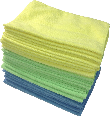Perhaps no everyday object takes as many stains as an article of clothing. However, removing stains from clothes may well be impossible if the stains are allowed to settle. The golden rule when removing stains from clothes is quick action. If you do not remove the stain quickly, your beloved shirt, blouse, skirt, or scarf may never see the light of day again. But there's one other important aspect to removing clothing stains—you have to know what stain removal technique to use for which material. The wrong treatment could result in permanent damage.
Since most stains are water-soluble, try washing your stain off with water first. If water does not work, try washing the stain with liquid detergent, another primary stain remover. In any case, when removing stains from clothes, you can't do without stain softeners like various acids and stain solvents such as commercial cleaning fluids and the likes of petrol, kerosene, etc. Other important allies for stain removal are absorbents like talcum powder, chalk, etc.
The most important thing about bloodstains is that only cold water should be used to remove them. For any bloodstain, soak the garment in cold water for at least thirty minutes before doing any other treatments. If the stain remains, soak the garment in lukewarm ammonia water, then rinse. If the stain still remains, soak it in detergent and wash it in the washing machine. If the stains are hard and dry, add some baking soda to a bowl of cold water and soak the garment in it for several hours. Wash the garment with bleach to complete the job.
For perspiration stains, sponge a fresh stain with ammonia or baking soda or, if it is an old stain, sponge it with white vinegar. Next, soak the garment in cold or warm water and rinse. If the fabric is yellowed by repeated perspiration stains and is colorfast or white, treat the stains with a bleach solution.
For clothing stained with chocolate or cocoa, pre-soak the clothes in cold or warm water, and then wash them in hot water with liquid detergent. If the stain remains, you should sponge the area with hydrogen peroxide and wash the garment again.
For tea, coffee, and fruit juice stains, sponge or soak the stained area with cold water as soon as possible after the spill, and then wash the garment using detergent and bleach. Another excellent agent for removing tea and coffee stains is glycerin, which you will need to rub in gently before you wash the stained clothing. For stubborn fruit juice stains, prepare a strong solution of borax and water. Make sure to wear gloves when working with borax. Rub the borax into the stain, let it sit for about five minutes, and then check to see if the stain has disappeared. Once the stain is gone, rinse the borax out with hot water.
For thick grease stains, sponge or soak the stained area with cold water as soon as possible after the spill, and then wash the garment using detergent and bleach. If the stain remains after the wash cycle, apply a dry-cleaning solvent and wash it again.
For soft-drink stains, sponge the affected area immediately with cold water and rubbing alcohol. If you use warm water and detergent, you risk setting the stain.
For milk, cream, and ice cream stains, soak the garment in cold water and then wash the stained area with soap and water. If necessary, remove any grease spots with a dry-cleaning solvent and wash the garment again.
For meat juice or curry stains, which will inevitably harden after some time, scrape off the excess material with a dull blade. Soak the garment in cold water and wash it with liquid detergent and bleach.
For ballpoint pen ink, first sponge the area with rubbing alcohol. Then, rub some petroleum jelly in to the stain and sponge it with a dry-cleaning solvent. Finally, soak the garment in detergent solution, and then wash it with detergent. For fountain pen ink, first rinse the stain with cold water until no more color runs. Apply a mixture of lemon juice and detergent and let it stand for twenty minutes. Wash off the residue with cold water.
For chewing gum stains, rub the area with ice and scrape off the frozen gum with a dull blade. Turpentine can remove any remaining chewing gum, but make sure to test it first on a hidden area of your garment, since it may damage some fabrics and dyes.
For crayon stains, first scrape off any excess crayon wax. Wash the garment in hot water with detergent and about a cup of baking soda.
In the end, removing stains from clothes may still be a problem if the stains are too stubborn. In that case, there's always the local dry cleaner!

The Power of Microfiber! Zwipes Microfiber Cleaning Cloths will become your favorite tool for every cleaning task. This 36-cloth package is perfect for hundreds of uses in the garage, kitchen, bathroom, laundry, and all around the house. Each cloth is tough, streak-free, lint-free, reusable, and washable. Check out Microfiber Cleaning Cloths today!
There are both wet and dry methods that will work for getting vegetable oil out of felt. The wet methods involve working ...
Discover MoreHair gel will rinse out in water, so once you remove the gel with a stiff edge rinse the stain in warm water. With a mild ...
Discover MoreHave you ever noticed just how stubborn sock stains can be? For some reason sock stains can be some of the most stubborn ...
Discover MoreFREE SERVICE: Get tips like this every week in Cleaning Tips from Tips.Net. Enter your address and click "Subscribe."
There are currently no comments for this tip. (Be the first to leave your comment—just use the simple form above!)
FREE SERVICE: Get tips like this every week in Cleaning Tips from Tips.Net. Enter your address and click "Subscribe."
Copyright © 2026 Sharon Parq Associates, Inc.
Comments